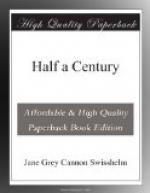The Bishop of the diocese, R.R. O’Conner, was, I think, a priest of the Capponsacchi order, one of those men by whose existence the Creator renders a reason for the continuance of the race. After the days of which I write, there was an excitement in Pittsburg about Miss Tiernan, a beautiful, accomplished girl, who became a nun, and was said to have mysteriously disappeared. When the Bishop resigned his office and became a member of an austere order of monks, there were not lacking those who charged the act to remorse for his connection with her unexplained death; but I doubt not, that whatever that connection was, it did honor to his manhood, however it may have affected his priesthood.
In the days of his Episcopal honors, he was a favorite with all sorts and conditions of men, and when he published a letter condemning our infant-system of public schools, and demanding a division of the school fund, he produced a profound sensation. I think this letter appeared in ’49. It was the morning of one of the days of the week I spent regularly at the office. I found Mr. Riddle waiting to ask what I proposed to do about it. I stated, without hesitation, that I would oppose it to the best of my ability, when he replied:
“I took it for granted that you would have consulted Mr. White (conductor of the Gazette), and we feel that we cannot afford to lose our Catholic patronage by taking issue with the Bishop, and that it will not be necessary. You, as a pupil of Dr. Black, ought to be able to answer Bishop O’Conner’s arguments, and we will leave him to you. The religious press will, of course, be a unit against him, and the secular press need not fear to leave the case in your hands.”
The two papers for which he spoke, were the two great Whig dailies of the western part of the State. The other daily was the Democratic Post, conducted by a Catholic, and virtually the Bishop’s organ; and to meet this attack on the very foundations of civil liberty, the Visitor, a weekly, was the only representative of the secular press.
The Whig papers might have taken a different course, had it been known at first that Bishop O’Conner’s letter was only a part of a concerted attack, and that all over the Union the Bishops had published similar letters. But this was before the days of telegraphy, and we were weeks learning the length and breadth of the movement.
Bishop O’Conner replied very courteously to my strictures on his letter, and we maintained the controversy for some length of time. Having all the right on my side, I must have been a dolt not to make it apparent; and the friends of the Bishop must have felt that he gained nothing, else they would not have been so angry; but he was courteous until he dropped the subject.




